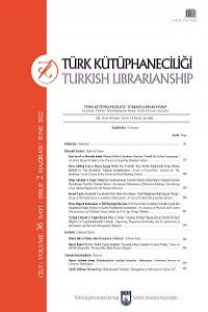Photograp hs as Archival Material
Fotoğrafların arşivcilik bilimi ve sürecinde doğaları ve/veya kimyasal yapılarının sonucu olarakortaya çıkan özelliklerinden kaynaklanan kendilerine has bir yeri vardır. Bu nedenle fotoğraflarınarşivcilik kurallarına göre korunması çok önemli bir unsurdur. Arşivcilik sürecinde arşiv malzemesinindeğerlendirilmesi ile ilgili iki temel değerlendirme kriteri vardır; tarihi değer ve kanıt değeri. Diğerbir ifade ile arşiv malzemesi özelliğinin kazanılabilmesi için öncelikle göz önünde bulundurulmasıgereken unsurlar tarihi değer ve kanıt değeridir. Bu noktada tarihi ve bilgi değeri olan fotoğraflar tekve benzersiz arşiv malzemelerinin en önemlilerindendir. Fotoğraflar, kağıt, görsel-işitsel ve/veya elektronik malzemeden farklıdırlar. Bu noktada arşivcilerinfotoğrafları değerlendirebilmeleri için uzmanlık bilgisine duydukları ihtiyaç ortaya çıkmaktadır. Bununyanında fotoğraflar söz konusu olduğunda sadece depolanmaları ve korunmaları için değil diğer tümsüreçler için de uzmanlık bilgisi gerekmektedir. Bu nedenle fotoğraflar arşivcilerin ele aldıkları en zorve uğraştırıcı arşiv malzemelerinden biri olarak da görülebilir. Bu çalışma kapsamında arşiv malzemesiolan fotoğraflar ile ilgili tüm önemli noktalar ve fotoğrafların arşivsel süreç kapsamında yönetimiincelenmektedir.
Arşiv Materyali Olarak Fotoğraflar
In the archival science and process photographs have their own unique position because there arespecial characteristics that result from their genre and/or chemical structure. Thus, it is of extremeimportance that photographs be protected according to archival rules. In archival science there aretwo major important appraisal criteria for archival material; historical and evidential values. In otherwords, to be treated as archival material, the historical and evidential value should first be determined.At this point it is clear that photographs that have a primary historical and evidential value are one ofthe most important archival material which are unique and precious.Photographs are unlike paper, audio-visual and/or electronic material. Specialist knowledge isrequired in order for archivists to evaluate photographs. Photographs are distinct in requiring expertise,not only for their storage and preservation processes, but for other processes too. Thus Photographscan also be considered to be one of the most compelling archival material for archivists to work with.In this study all the important points about photographs as archival material and the management ofphotographs through archival practice will be discussed.
___
- Archives Association of British Columbia. (1999). A manual for small archives. Vancouver: Archives Association of British Columbia.
- Bantin, J. and Agne, L. (2010). Digitizing for value: A user-based strategy for university archives. Journal of Archival Organization. 8 (3-4), 244-250.
- Benson, A. C. (2009). The archival photograph and its meaning: Formalisms for modeling images. Journal of Archival Organization, 7, 148187.
- Brunton, P. and Robinson, T. (1993). Arrangement and description, J. Ellis (Ed.), in Keeping archives, 2nd Edit., (pp: 222-247). Australia: Thorpe.
- Charbonneau, N. (2005). Selection of photographs. Archivaria (59), 119-138.
- Duchein, M. (1985). The principle of provenance in archives administration. P. Walne (Ed.). in Modern archives administration and records management: A RAMP reader, (pp: 85-110).Paris: UNESCO.
- Duranti, L. (1994). The concept of appraisal and archival theory. American Archivist (57), 328- 344.
- Forde, H. (2007). Preserving archives. London: Facet Publishing.
- Hendriks, K. B. (1977). The preservation of photographic records. Archivaria (5), 92-100.
- Hendriks, K. B. (1984). The preservation and restoration of photographic in archives and libraries: A RAMP study with guidelines. Paris: UNESCO.
- International Records Management Trust. (1999). Glossary. Managing public sector records: A study programme. London.
- Ketelaar, E. (2006), Writing on archiving machines. Neef, S., van Dijck, J. and Ketelaar, E. (Edit.), in Sign here! Handwriting in the age of new media. Amsterdam: Amsterdam University Press, 7-19.
- Leary, W. H. (1988). Managing audio-visual archives. J. G. Bradsher (Ed.), in Managing archives and archival institutions, (pp: 104-121). London: Mansell Publishing.
- M. N. E. (1984). Organizing photo collections: An introspective approach. M. F. Dainels and T. Walch (Eds.), A modern archives reader, (pp: 181-187).Washington: National Archives and Records Service.
- Millar, L. A. (2010). Archives: Principles and practices. London: Facet publishing.
- M. R. Pearce. (2005). A glossary of archival and records management terminology, Chicago: The Society of American Archivists.
- P. J. Astle and Adrienne M. (2002). Digitization and preservation in public libraries and archives. Journal of Librarianship and Information Science, 34(2), 67-79.
- Queensland State Archives. (2010). Glossary of archival and recordkeeping terms, Queensland Government. Retrieved December 12, 2012 from http://www.archives.qld.gov.au
- Ritzenthaler, M. Lynn. (1993). Preserving archives and manuscripts. Chicago: The Society of American Archivists.
- Roberts, D. (1993). Managing records in special formats. J. Ellis (Ed.), in Keeping archives, 2nd Edit., (pp: 385-428). Australia: Thorpe.
- Schellenberg, T. R. (1956). Modern archives: Principles and techniques. Chicago: Midway Reprint.
- Schellenberg, T. R. (1984). The management of archives (2nd Ed.). Washington: National Archives and Records Administration.
- Shepard, E. (2005). Digitizing a photographic collection in a midsize repository: A case study. Journal of Archival Organization, 2 (4), 67-82.
- Swartzburg, S. G., Bussey, H. and F. Garretson. (1998). Libraries and archives: Design and renocation with a preservation perspective. London: The Scarecrow Press.
- Taylor, H. A. (1980). The arrangement and description of archival materials. München: International Council on Archives. The national archives. Caring for your photographs, Retrieved February 6, 2013 from http://www. nationalarchives.gov.uk/documents/
- Williams, C. (2006). Managing archives: Foundations, principles and practice, Oxford: Chandos Pub- lishing.
- Başlangıç: 1952
- Yayıncı: Türk Kütüphaneciler Derneği
Sayıdaki Diğer Makaleler
Potansiyel Kütüphanecilik Projeleri
Photograp hs as Archival Material
Bilgi Okuryazarlığı Becerilerinin Kazandırılmasında Okul Kütüphanecilerinin Rolleri ve Algıları
Determinants of User Acceptance of Digital Libraries
Mesut KURULGAN, F. Zeynep ÖZATA
